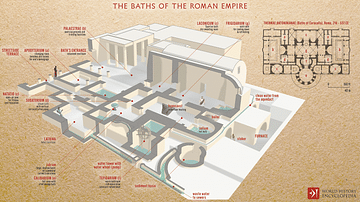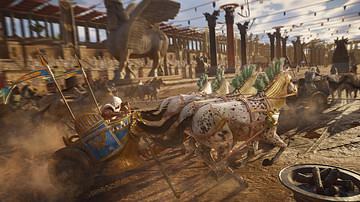
The Gymnasium was a Greek building originally used for athletic activities but which came, over time, to be used also as a place of study and philosophical discussion. In the Hellenistic Period, gymnasia became highly standardized both in architecture and function and continued their important role in a young male's physical and general education. They became a common feature across the Greek world and were adopted and adapted by the later Romans, eventually evolving into the huge multi-purpose complex that was the Roman baths.
Origins of the Gymnasium
The name gymnasium (gymnasion) derives from the Greek word for nudity (gymnos) as all exercise and sports were done by the male only members in the nude. The earliest recorded examples of gymnasia date to the 6th century BCE and were simple affairs consisting of an area of packed earth shaded by trees located somewhere close to a river or spring. They were especially common at sanctuary sites such as Delphi, Olympia, and Nemea.
The gymnasium may have evolved from the necessity for a dedicated space where young Greek men (ephebeia) could train and improve their fitness to make them ready for warfare. In battle they would fight as hoplites and so have to wear heavy bronze armour and carry a large bronze shield. Another view is that gymnasia were reserved only for the aristocracy and so came to be a place where men could demonstrate their physical, as well as their social, superiority to the lower, agricultural class.
The typical sports practised were wrestling, running, boxing, jumping, discus, and gymnastics. Many would have been accompanied by rhythmic music. Sports useful for warfare included archery, javelin, armed combat, and using catapults. Sports were supervised by a trainer or paidotribe, perhaps an older athlete who had gained experience at the great Games of Greece. An aleiptes was responsible for oiling and massaging members. Each year a competition might be held too, the Hermaia, where members of the gymnasium participated in a torch race and competed in three categories of events: vigor (euexia), discipline (eutaxia), and endurance (philoponia).
Evolution of the Gymnasium
Gymnasia not only became a common feature of sanctuaries and sites famous for their sporting games but also in ordinary cities. Athens had, for example, a gymnasium at the Academy of Plato and in Aristotle's Lyceum. These instances illustrate that the gymnasium became a place not just for sport and young men but for men of all ages and a place where citizens might discuss the topics of the day at their leisure. They, therefore, became centres of intellectual endeavor, which even came to surpass, but never completely substitute, their function as a place of exercise. In Classical Athens, the gymnasia were, in effect, like our modern universities, where members could listen to lectures and speeches. In the Hellenistic period they changed again, becoming more like secondary schools but never losing their physical purpose where young men trained on a daily basis.
The gymnasium is frequently mentioned in literary sources, especially in Plato's dialogues. The famous philosopher describes them as a place where one of the key relationships in Greek society developed. That is between a young boy (eromenos) and a young man (erastes) where the two would become lovers and the younger party would learn from the tutoring and life experience of his elder.
By the Hellenistic Period the gymnasium had become a well-developed and much-frequented institution. One of the reasons for this was that Hellenistic rulers, conquering new territories and building new cities, wished to stamp the Greek identity on their new acquisitions and gain prestige for their city by sending athletes to do well at the various Panhellenic Games.
The Hellenistic gymnasium was run by the city and managed by a dedicated official, the gymnasiarch. A 2nd-century BCE stela from Beroia describes in greater detail his function. He was responsible for the general administration and accounting of the gymnasium and also had the power to impose fines or even physical punishment such as flogging for those members who broke the house rules. The stela goes on to describe who can attend the gymnasium – free males up to the age of 30 – and who cannot – slaves, freedmen, tradesmen, male prostitutes, drunkards, madmen, and the physically unfit (apalaistroi). Women are not mentioned on the list but were excluded, a point felt too obvious to mention.
Architecture of the Gymnasium
By the 3rd century BCE, the gymnasiarch oversaw what was now a major architectural complex. The original exercise area had become enclosed with colonnaded buildings (stoas) which offered a place to sit and talk. Thus a peristyle was formed, which gave its name to the palaistra, the area specifically for wrestling. The two terms gymnasion and palaistra thus became synonymous over time. Washrooms with a supply of running cold water, bathtubs, an oiling room (elaiothesion), fountains, shrines, and rooms for studying were now a typical part of the complex.
Extra sporting facilities were added nearby such as a running track (paradromis). Sometimes there was also a covered running area, a xystos, to protect the athletes from the elements. At such cities as Pergamon and Priene, there were even full stadiums built for running, as at sporting sites such as Olympia. The gymnasium at Pergamon would become one of the largest ever built and covered around 30,000 square metres. These later gymnasia would also have had decorative sculpture and statues dedicated to the patron of the gymnasium (for example, Hercules or Hermes), a prominent member of the city who had given funds for its maintenance, and rulers.

Gymnasia in the Roman Period
The Romans continued and developed the idea of gymnasia and, while maintaining some as centres of learning, went on to construct huge bath-houses with still the same original Greek function as a place to exercise, bathe, and study. Built on a much grander scale, these baths became focal points of city-life and benefitted from hot baths, swimming pools, libraries, and decorative art. Gymnasia continued to exist separately from baths, though, and, in many ways became a focal point for Greek cities to maintain their identity in the Roman world. Gymnasia were also positively encouraged during the reigns of philhellene emperors such as Hadrian and Antoninus. Of course, the institution survives today. The intellectual element has long gone, but that is, after all, how they started - a dedicated space for a purely physical purpose amongst the olive groves of ancient Greece.







